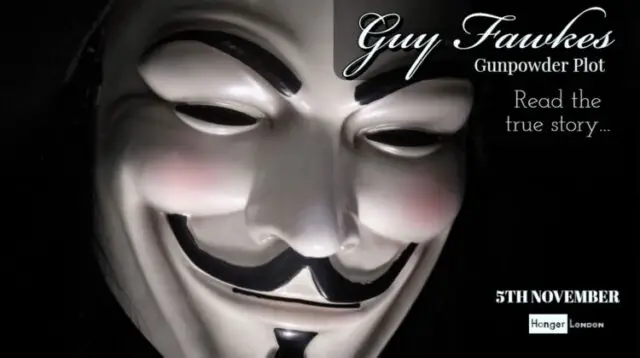Westminster, London 1605, the Houses of Parliament and the elaborate plot to blow it up
These were troubling times in England, it was illegal to be Catholic, despite the brief return to Catholic rule under Queen Mary 1 a few years earlier. In 1559 Queen Elizabeth passed an updated Act of Supremacy and in the same year the Act of Uniformity which reinstated the Church of England as being the compulsory religion. Those following other religions would face execution.
Thomas Wintour was in Spain with his cousin Robert Catesby, looking for men, to join the conspirators who would stand up for the Catholic rights back in England. It was here where Wintour came across someone who had fought for the Spanish King against the protestants in Holland, Guy Fawkes, and Robert Keyes,
In 1604 Keyes and Fawkes returned to England to start their new life as potential assassins. Robert Catesby’s plan was to assassinate King James 1st, the Queen, and the air at the state opening of parliament so that the only viable Catholic princess would become the new monarch.
Guy Fawkes was part of this legendary Gunpowder plot to realise this plan, a plan to trigger a Catholic Revolution.
Fawkes was not from London, he was from York, a place where Catholic resistance was active. On the 5th November 1605, Guy Fawkes was caught, just before he was about to set light to 36 barrels of Gun-Powder.
Here is a list of the men known as conspirators of the Gunpowder plot
- Robert and Thomas Wintour,
- Thomas Percy, a brother in Law to the Wright brothers.
- Christopher and John Wright, classmates of Fawkes
- Francis Tresham, 2nd cousin of Catesby
- Everard Digby,
- Ambrose Rookwood,
- Thomas Bates, servant of Tresham
- Robert Keyes,
- Hugh Owen,
- John Grant brother-in-law to the Wintour’s
- Robert Catesby the man who is said to have organised the whole plot
Guy Fawkes Also known as Guido Fawkes
Key players in the Gunpowder plot
- Jack Lambert
- Young male assistant to Sir Robert Catesby
- Mrs Ashby, Landlady
- Sir Robert Cecil, England’s top spy
- King James 1st, King of England
- Baron Monteagle
- Duke of Suffolk
- Robert Keyes
Guy Fawkes’s mother was a catholic, his father was a protestant, but died when he was young. His mother remarried a catholic. When he was 21, he joined the Catholic Spanish army. It is here that he gained experience with explosives.
Which King did the gunpowder plot target and why?
The Protestant King, King James Ist was the target, the activists wanted a Catholic to replace this monarch. These where times of deep religious intolerance, Catholic priests were being ordered to leave England. Executions were widespread, people were being accused of being witches just for being Catholic.
The North Berick witch trials being one example, where the king himself was one judge. Not exactly fair considering James I was totally into witch-hunting and believed it justified the punishment.
In 1597, the book “Daemonologie”, that the king himself wrote was published. All about demonology black magic. Shakespeare took the inspiration and made many other connections from this book.
The truth behind the planning of the Gunpowder plot
The plot involved building a tunnel from a house near to the House of Lords, this was the home of Percy. They postponed the State Opening of Parliament until February 1605.
This meant the men would split up and not see each other again until late Autumn 1604. By December they started digging the tunnel. They transported the Gunpowder from Catesby’s house to Percy’s house.
Thomas Percy got a job as a royal bodyguard. This is how he got a dwelling close to Parliament. Guy Fawkes could sneak in as one of Percy’s servants.
Percy had also rented a vault under the house of Lords to lessen the need to dig tunnels and allow faster delivery. The Gunpowder had been stored ready for ignition.
Parliament postponed the reopening once more, this time till late Autumn of 1605, this was because of paranoia around the Plague.
It is thought Catesby had a home across the Thames in Lambeth, a picture of this can be found in the London Metropolitan archives, it is not clear of the exact location. Items for the gunpowder plot where stored at the Lambeth address so we consider it that Guy Fawkes would have visited the location.
The Tip off that lead to Fawkes being caught
Lord Monteagle, Francis Tresham’s brother-in-law, with a warning not to attend the 5th of November 1605 State Opening of Parliament.
“they shall receive a terrible blow”.
Robert Cecil, one of the King’s senior advisors is shown the letter. Meanwhile, eavesdropping servants alerted the conspirators of the risk that the plan was exposed. Catesby suspected his relative Tresham and confronted him as a traitor. Tresham denies grassing up the plan but discourages Catesby from getting involved.
The King believes the wording in the letter hints at the use of Gunpowder and orders a thorough search of the houses of parliament buildings. Catesby is not aware that this was now a full-scale investigation.
Guy Fawkes alias was John Johnson, working for Percy. When he was caught with matches and lamp and near the stack of gunpowder, he still tried to maintain this alias. He was arrested questioned. The King admired Guy for remaining true to his cause
he claimed he was sorry he had not succeeded in blowing the Scottish king back to where he had come from.
Guy Fawkes was sent to the Tower of London and exposed to gentle torture until he confessed around the 9th of November. The Queen’s house a Tudor building is where this took place.
Execution of Guy Fawkes
They executed guy Fawkes for treason in 1606 and his remains sent to the four corners of the UK as a warning. The Four corners of the UK some may consider as Scotland, England, Wales and Northern Ireland. However, in 1606 this may be up for discussion since the UK had not been formed so it may well have been four corners of England or 4 prominent points;
- Land’s End, England
- John O’Groats Scotland
- Lowestoft, England
- St. David’s, Wales
It was the king that suggested the 5th of November be celebrated annually with bonfires. They burned an effigy of Guy Fawkes on fires up and down the country. Fireworks followed.
From around 1606 on the anniversary of November the 5th there were special Gunpowder Sermons delivered by Lancelot Andrews a high up Bishop of the times. Around this time the nursery rhyme was instigated to make sure this act of treason would never be forgotten
“Remember , remember the 5th of November
Gunpowder, treason and plot.
I see no reason why gunpowder, treason
should ever be forgot”.
Conspiracy theories suggest the Gunpowder plot was a government initiative
Could the whole gunpowder plot have been an undercover conspiracy headed by potential candidates like the Earl of Salisbury, to convince the king Catholics were untrustworthy? Chief minister Cecil wanted the religion removed from England totally he could have also played a role in a conspiracy. The King was paranoid in some ways. Fears of violent death from childhood traumas of kidnapping. So the conspiracy theories suggest he was being scare mongered that a plot was out to assassinate the king.
Other theories speculate that the plotters were part of the king’s men who would turn at the last minute and come out triumphant over Catholics and this would boost the king’s popularity and convince people Catholics were bad.
The Tower of London stored Gunpowder. It was mainly only available in large quantities to those who had authority and worked for the king/government. If there was government, conspiracy officials would have helped with the 36 barrels of gunpowder changing hands. That amount of gunpowder would be at risk of being spotted during transportation. It could get damp if it sailed.
All the activists were catholic and had to change their names to avoid being suspected, some say this would have been tricky to have kept up for so long considering the group of men were either related or friends.
They killed Catesby and Percy before interrogation
The officer who killed them was given a very large pension for the rest of his life, but if they had tortured the men, they would have found the names of the others unless there were no others and this was a way to cover this up.
Places in London Connected with Guy Fawkes
The Duck and Drake Tavern believed to have been somewhere on the Strand, where the conspirators met and swore an oath of secrecy.
Houses of Parliament, Westminster, Old Palace Yard the site of executions. Tower of London, the Queen’s House where Fawkes was held as a prisoner and tortured there for a confession




